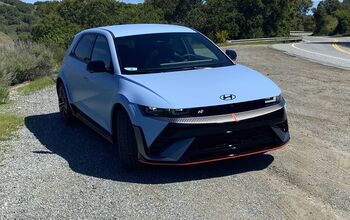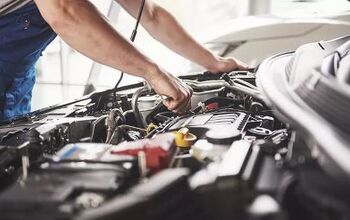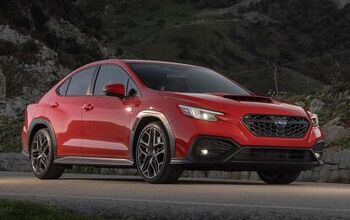Where Does Volvo Go From Here?

Let’s talk about Volvo. You know Volvo. It’s your favorite Swedish brand. It’s my favorite Swedish brand. It’s everyone’s favorite Swedish brand, except for 13-year-old boys who are still holding out hope that the local rich guy will buy a Koenigsegg and bring it to Cars and Coffee.
The reason we all love Volvo so much is, of course, its rich and colorful history. Now, I don’t actually know any of this history, but if you contacted Volvo’s PR department I think you’d find that it began in roughly 1966 when Irv Gordon bought that 1800S they’re always putting in ads to prove that Volvo has, on at least one occasion, built a car that didn’t start leaking fluids nine hours after the warranty expired.
Of course, I kid. Volvo used to make many dependable automobiles. I know this because my high school parking lot was full of Volvo 240 sedans and wagons, battle-scarred after years of providing reliable family transportation, that were passed down to adolescent males who used them to drift in the snow.
But Volvo is more than box-shaped family transportation. They’ve had some fun cars, too. Take, for instance, the 850 T-5R, which singlehandedly transformed Volvo’s reputation from a brand that builds boring cars to a brand that builds slightly exciting cars and paints them yellow. And who can forget the highly enjoyable S60R and V70R, which are currently scraping parking curbs all over North America?
It’s cars like these – and several others that I’ve probably forgotten about, since my research for this article consisted primarily of looking out the window – that have earned Volvo so many fans. And that’s why I, like so many of you, was completely dismayed several weeks ago to learn Volvo will disappear in 2014.
Of course, this information didn’t come from Volvo. It came from a website called “Wall Street 24/7,” which I would describe as “middling” except that it has 10 times as many Twitter followers as TTAC. If you’re unsure why I bring this up, it’s because people my age equate “number of Twitter followers” with “importance.” By this sound logic, Justin Bieber is more important than Barack Obama. Some of you may actually agree with that.
Anyway, “Wall Street 24/7” posted an article entitled “Things That Will Disappear in 2014,” and one of those things Volvo, which sent everyone into a frenzy because there’s no way Volvo can disappear in 2014, because if that happens then how will I replace my S60R’s scraped front bumper? Interestingly, the article also cited Mitsubishi, which sent absolutely no one into a frenzy, though it did remind most of us that Mitsubishi still builds cars.
But could the article be accurate?
No. Not at all. The idea of Volvo disappearing next year is ridiculous, considering that Lotus still hasn’t disappeared even though its employees think of Rolls-Royce as a “volume brand.”
But that doesn’t mean things are rosy for Volvo. Last year, they only sold 68,000 cars in the US. That may not sound so bad, but here’s the number from another perspective: during the same timeframe, Mercedes sold 82,000 C-Classes. Yes, it’s true: Volvo sold 20 percent fewer cars, in total, than Mercedes sold C-Classes. Mercedes sold almost four and a half times more cars overall.
So the question is: where does Volvo go from here? Fortunately, I have a two-step plan that I believe will guide them to safety. (Get it? A plan that will guide Volvo … to safety? OK, fine, don’t laugh now, but you’ll be telling that joke at Cars and Coffee.) The plan is:
1. Stop with the sporty stuff. Yes, the 850 T-5R was cool. And the V70R was cool. And the S60R was brightly colored. But that doesn’t mean every Volvo needs an R-Design trim level, big wheels, and a bodykit. Here’s the thing: everyone is going sporty. Even Mercedes – former manufacturer of vehicles with extra-large parcel shelves for tissue box placement – is increasingly becoming a major player in the high-performance realm.
But here’s the thing: not everyone wants sporty. Some people still want a safe, dependable, durable, boring luxury car, which brings us to…
2. Go back to your roots. The Volvo of years past built solid, well-designed cars that were known, above all, for keeping you safe in a collision. The Volvo of today builds a two-door hatchback with challenging rear-seat access. Return to the land of durable and safe, and you’ll find shoppers who want the same. I know this because they’re all still driving 1996 850 wagons with no sunroof and thinking: I hope I don’t crash this, because I’ll have to replace it with something that has a bodykit.
Using my simple strategy, Volvo could easily retake its rightful spot among Brands Whose Demise Isn’t A Possibility in just a few short years. Of course, Volvo won’t get there with only my strategy. They’ll need some help. A testimonial, perhaps. Or few nice pictures. Or maybe a guy who put three million miles on his 1966 1800S.
@DougDeMuro is the author of Plays With Cars and the operator of PlaysWithCars.com. He’s owned an E63 AMG wagon, road-tripped across the US in a Lotus without air conditioning, and posted a six-minute lap time on the Circuit de Monaco in a rented Ford Fiesta. One year after becoming Porsche Cars North America’s youngest manager, he quit to become a writer. His parents are very disappointed.

More by Doug DeMuro
Latest Car Reviews
Read moreLatest Product Reviews
Read moreRecent Comments
- Parkave231 New Oldsmobiles are in early this year.
- MaintenanceCosts "While there are absolutely exceptions, the days of the super-sleazy used car dealer seem to be behind us here in the States."Citation needed.
- SCE to AUX Sounds like the written-off cars didn't even have enough life in them to survive the short warranties. The scheme would have lasted longer if the cars were sold as-is.Is "written off" similar to an "R" or "S" title in the US?
- AZFelix Not enough charging stations. Long wait times. Do not recommend.
- 2ACL I love the CV6 + stick pairing, even if it's not particularly quick (or efficient) by modern standards. It looks to have a solid foundation and would be nice to drive fully sorted, but Honda/Acuraphiles seem more interested in ressurecting second generation cars. I wanted a manual GS sedan for the longest time, though I'd have gladly taken a first generation manual coupe. Thankfully, we're spared of 'future collectable' pricing with this one.


































Comments
Join the conversation
I am a bit surprised by the discussion omitting one aspect - from the figures quoted somewhere in there, the US and Chinese market account for less than a third of the total volume, yet 99% of the discussion on how to get it right. I imagine the 70%, which are more or less all sold in Europe are an equally pressing, and possibly more important headache. And there the traditional space you mention with the 144 and 240 has largely been occupied by Skoda at a price point, where Volvo cannot hope to turn a profit with their low volumes. At the same time they have gradually lost the cool that in many cases came with turbocharged 850 estates (and much less with the RWD predecessors) and competing with the premium set, such as Audi, BMW and MB never really successfully materialized. Another point to mention - practicality and roominess took several steps back, as commented on already and the modern V60 or even the by now ancient V70 are pretty much bottom of the league in interior / boot space in their segments. So no longer quadratisch praktisch gut. There are other issues. The 5 cylinder diesels are pretty much the roughest and weakest in the market for larger / more powerful diesels and harsher, thirstier, less reliable... than many of the competitors 4 cyls. The volume 4 cyl diesels are middle of the pack but not in the same league as something coming from say BMW (the 6 cylinder petrols make up a minute proportion of engines sold in Europe, and really do not matter volume wise). In spite of being under Ford ownership for over 10 years, they still did not manage to sort out their handling / ride to become class competitive. There are other issues - the top speeds of the cars are often comparatively lower than similarly powered German models, which while irrelevant in many countries, makes them a harder sell in Germany. Another, unrelated point - the much maligned first gen S80 was developed wholly by Volvo, prior to Ford involvement, so Ford cannot really take the blame for that one. And rightfully maligned it is, too - at least according to the experience of pretty much every owner I know (including the one in our family). Having put over 500k km (300k miles) on various Volvos during my life, and still keeping a 1995 850T-5R in a garage for an occassional fun drive, it pains me to say this - but in the current state, with the volumes sold and the investment necessary to make it, I do not see a bright future for them, or much of a need for the brand. Sure, they do include premium engineering lacking from the more mainstream competitors - as mentioned their safety goes beyond excelling at tests only (in fact they have been soundly beaten in EuroNCAP testing by Renault for quite a while); their turbocharger installations are certainly no problem reliabilitywise - our 850T-5R at 250k miles and the S80T-6 at around 125k are both on their second engine but still the original turbocharger... A lot of this only shows up in the incredibly rare event of a crash, or if you keep the car for 10 years or more - also something few modern Volvo owners tend to do (especially since - in Europe at least - Volvos tend to be sold via super aggressive financing deals first and foremost). And there are so many mundane car parts that start going wrong way before then that few people would want to persevere with a Volvo for so long anyway. And last but not least, their current volumes mean amortising R&D over too few vehicles, which means either narrowly specialising, or progressively falling behind in certain areas - something we have seen with the rather longish product cycles and the lack of a continuous stream of new product.
Worldwide Volvo July sales figures hot off the press. Percentage difference over July 2012; (1) China - Up 61.6%!!! And, although the Chinese factory is built, it won't be running til the Fall. (2) US - Up 3.3% (3) EU20 - Up 16.8% Total Sales - UP 14.0% No need for panic with those numbers.